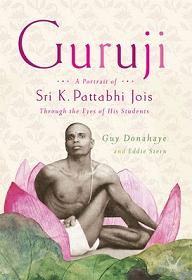 With the imminent (er, slightly delayed, Amazon!) UK release of Guruji by Guy Donahaye and Eddie Stern it seems fitting to write a post on essential Ashtangi reading. There are loads of books about Ashtanga yoga. For example you may want to know: ‘The correct vinyasa count for Surya Namaskar B’ or ‘who or what is Kurmasana?’ to ‘What does the opening Mantra mean?’. Here is my definitive list (so far). If I’ve left any out I’d love to hear from you.
With the imminent (er, slightly delayed, Amazon!) UK release of Guruji by Guy Donahaye and Eddie Stern it seems fitting to write a post on essential Ashtangi reading. There are loads of books about Ashtanga yoga. For example you may want to know: ‘The correct vinyasa count for Surya Namaskar B’ or ‘who or what is Kurmasana?’ to ‘What does the opening Mantra mean?’. Here is my definitive list (so far). If I’ve left any out I’d love to hear from you.
In my opinion there are only two short books that I regard as essential reading for Ashtangis (These were first suggested to me by Shari Berman and after reading both books I wholeheartedly agree).
- Yoga Mala – By Shri K Pattabhi Jois
- Astanga Yoga – By Lino Miele
For students and teachers
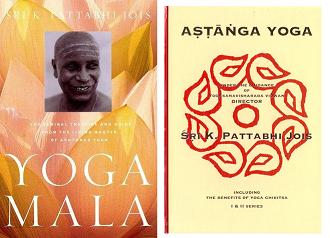
Yoga Mala is Guruji’s book on Ashtanga Yoga originally published in the Kannada language in India back in 1962. It’s written from the source of Ashtanga Yoga and includes essential information on Patanjali’s Ashtanga yoga (8 limbed path). It details the correct vinyasa count and health benefits of each posture in the primary series. It’s interesting to note that there is no sign of Urdhva Dhanurasana at the end of primary series. This must have been included in the practice later.
Yoga Mala is not naturally pallatable to the modern Western reader – for example sexual intercourse for yogis should only be engaged in when the air is moving through chandra nadi. So when one feels air travelling more clearly through the left nostril. There is however a yogic framework for living that the book adheres to and that the Ashtanga practice is very much a part of. This is one of the reasons I think it makes for essential reading. There is more going on than what happens on the mat!
Yoga Mala only covers the primary series which is partly why Lino Miele’s book is such a useful addition. It covers both primary and intermediate series. The great feature of Lino’s hardback is the format of how the vinyasa count and dristi are all so clearly laid out for each asana. It’s super clear – including inhalation, exhalation, sanskrit count for each vinyasa, drsti and number of breaths held in the asana. There is also a really good section on the 5 vayus, pranayama and the chakras. It also includes the closing mangala mantra with translation. (John Scott’s book also includes both opening and closing mantras.)
Recent books on Ashtanga Yoga
Gregor Maehle has also written two great books on Ashtanga Yoga. They’re packed with lots of detail – both anatomical and philosophical. The first book also includes a modern commentary on the Yoga Sutras. Mr Maehle keeps the practice firmly rooted in it’s philosophical tradition and context which I really appreciate.
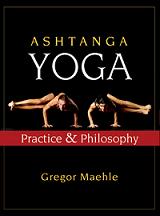
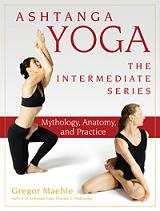
- Ashtanga Yoga – Practice & Philosophy
- Ashtanga Yoga – The Intermediate Series – Mythology Anatomy and Practice
Ashtanga Practice Manuals
This is an interesting category and although most books on Ashtanga Yoga contain pictures on Asana and instructions on drsti, bandhas, they aren’t designed to have open while you practice. (I’ve never done this myself but I understand that home practitioners would do this while learning the sequence.)
- Ashtanga Yoga – The practice manual – By David Swenson
- Astanga yoga as it is – Matthew Sweeney
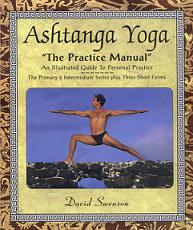
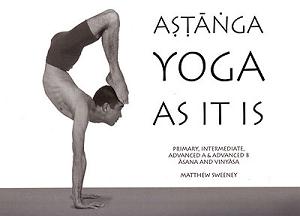
Both books are ring bound so you can open them up and have them on the mat next to you. Matthew Sweeney’s book is definitely far more in depth and comprehensive than David’s. The only downside is that in order to incorporate 4 Ashtanga series the pictures are much smaller than in David’s book. But it’s a small trade off to make. You really get a sense of the scale of the practice from Mr Sweeney’s book. He also has an engagingly direct writing style that I enjoyed.
Books for beginners
- Ashtanga Yoga – John Scott
- Ashtanga Yoga – Practice Manual – David Swenson
- Astanga yoga for you – Tara Fraser
I still think that every Ashtanga practitioner should read Yoga Mala. But it’s not entirely accessible to practitioners who are new to yogic concepts and language. In this category I’d included David Swenson’s practice manual (it has good modifications – I’ll write a post on this topic too one day!
John Scott’s book was my first purchase with his primary series DVD and it’s a great introductory guide, with lots of colour photography, it’s also well laid out and very useful. There’s a great section on advanced back bending (or assisted drop backs). His DVD is positively inspiring or depressing depending on your mood.
Finally I’ve included Tara Fraser’s book because while she’s not an Ashtangi she explores the Ashtanga practice in a very approachable clear way. Again the layout is good with lots of tips and variations for beginners.
If you’ve made it this far then you deserve a cup of tea before you hit Amazon and start expanding your library!

No comments yet.